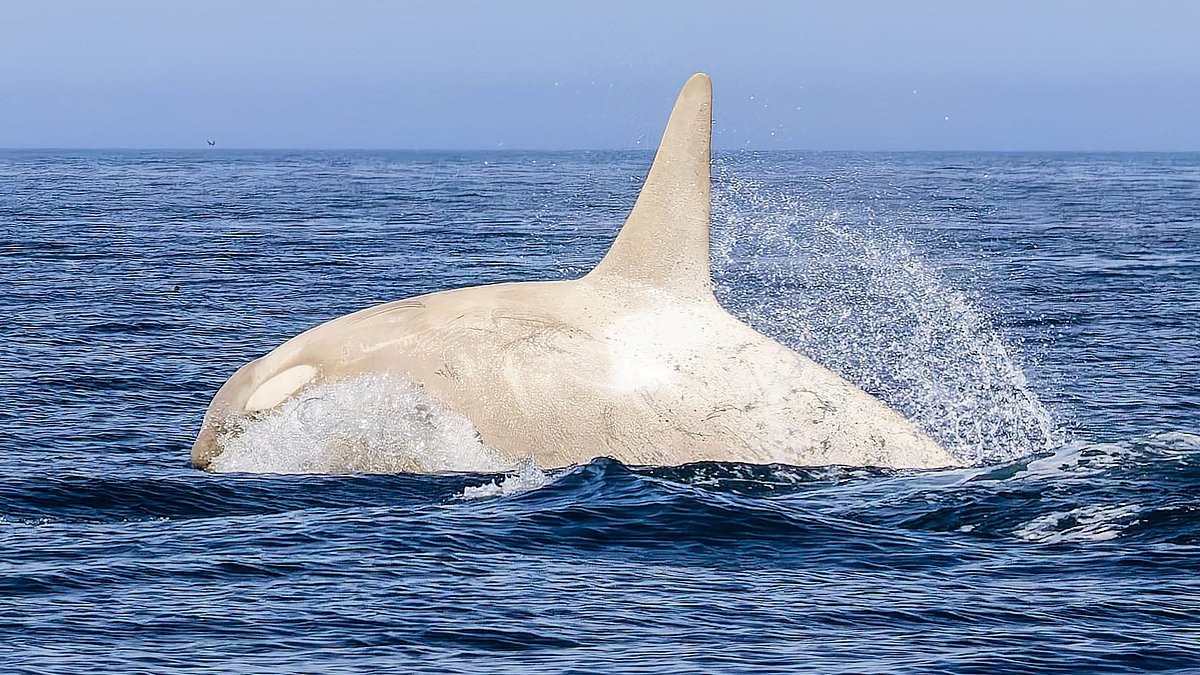A life-long whale-watcher was ‘shaking with excitement’ when he spotted a rare white killer whale while swimming in a pod of normal coloured orcas.
The albino or leucistic orca is part of a small group of just three white orcas known to have appeared off Japan’s volcanic island Hokkaido.
Often, albino animals are shunned by their pack because the white colouring can make them stand out to predators.
But this marvel of nature luckily seemed to be accepted by their pod as they were seen jumping alongside other whales who had the usual colouring.
Despite the protection of the other whales, the albino orca was covered in gnarly scars to show its battle wounds from the open ocean.
The unique orca is not not ‘true’ albino, which is caused by a genetic trait that means the affected animal produces no melanin at all – the compound that gives skin, hair, feathers and eyes their colour.
True albinos will be completely white and have red eyes – a colour given by the red blood in vessels which are usually hidden behind the iris showing through.
The creamy-coloured beauty instead had vaguely whiter patches surrounding the orca’s chin and eyes which showed it was leucistic – meaning it lacks pigmentation, rather than having none at all.
The glaring scars might also suggest leucism as the scar tissue contains more pigment than the rest of the skin, hence why the wounds are difficult to miss.
Photographer Noriyuki Hayakawa captured the albino orca after another nearby tourist vessel spotted them and radioed Mr Hayakawa’s boat.
‘My legs were shaking with excitement,’ the 64-year-old said. ‘It was the first time in my life I’d seen a white orca. I was desperate to get a shot, they swim fast and only surface for a moment.’
The freelance photographer, based in Sapporo, has spent the past 15 years documenting the orca population around Japan.
But nothing prepared him for what he experienced that day on a tourist boat in the frigid northern waters.
The sighting last summer was entirely unexpected, as Mr Hayakawa hadn’t set out that day specifically looking for the rare creature, as reported by What’s The Jam.
‘This photo means so much to me,’ Mr Hayakawa said. ‘I’ve spent over a decade photographing orcas and this is the first white one I’ve ever seen.
‘I hope as many people as possible get to see it and appreciate how rare and beautiful these animals are.
‘I received a lot of comments saying it’s fake, that it was made with AI or edited,’ Mr Hayakawa added. ‘But it’s real. I was there.’
The photographer shared his discovery on Instagram, where he further wrote: ‘My legs were shaking as I photographed the white orcas I met for the first time.’
He added that it ‘looks like a golden-ish cream-colored orca synthesized into a blue sea. I still think it was a dream’.
Mr Hayawaka returned a second time to the same spot soon after in the hopes of another glimpse at the unique creature.
To his joy, he spotted another – a female albino orca.
He was able to spot that she had black eyes, which helped him prove that the rare animals were more likely to have leucism.
There is a high chance these whales inherited their leucism from their parents.
This area has been a hotspot for spotting these rare animals, with two others spotted in 2021.
The albino orcas were spotted during a whale-watching tour in the summer across a 20-mile stretch of water between the northern islands of Hokkaido and Kunashir.
Mai, an employee of the Gojiraiwa-Kanko tour company, said one of the pair was older with slightly darker skin while the other was younger and had clearly-visible scratch marks down its back.
She said the older whale was first spotted around two years ago but it is the first time she has seen the younger animal and the first time she has seen both of them together.
‘It was the best day ever. This is the first time two white orcas have been seen off the coast of Japan,’ she said.
It is unknown whether these two whales are the same as the spotting by Mr Hayakawa some years later.
White orcas and whales were once so rare that they were thought to be a myth, but are becoming increasingly common, with scientists aware of at least five individuals alive at the time of the sighting.
It is not clear exactly why they are becoming more common, but scientists theorise that it may be down to dwindling numbers of the whales and is a sign the species is in trouble.
As the population of a species declines, so does its genetic variation because the animals left have fewer potential mates to choose from.
Depending on the genes carried by those remaining individuals, it could accentuate some traits that were previously thought of as genetically rare.
That includes rare genetic disorders that hamper an animal’s ability to survive in the wild, threatening to accelerate the species’ decline.
